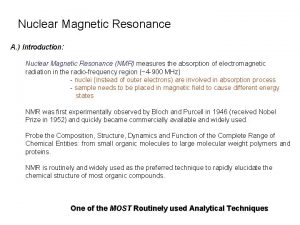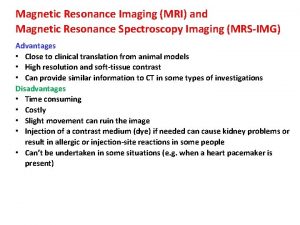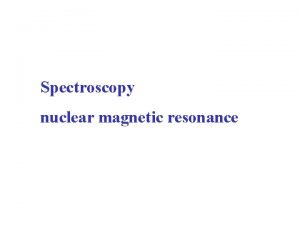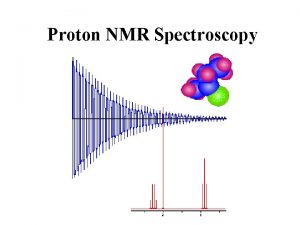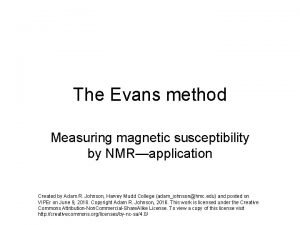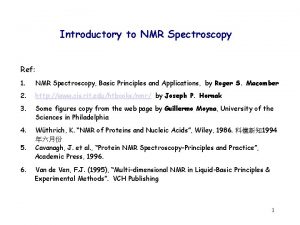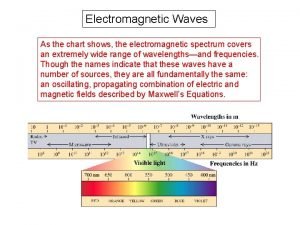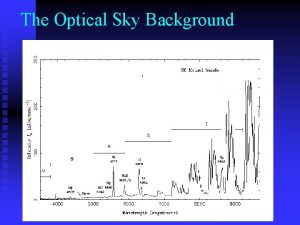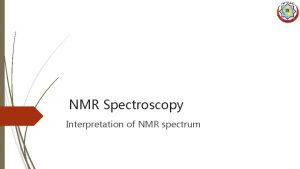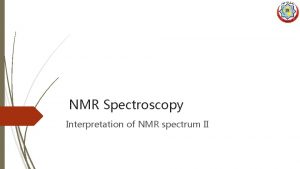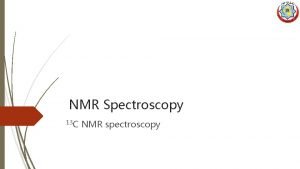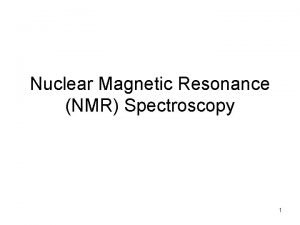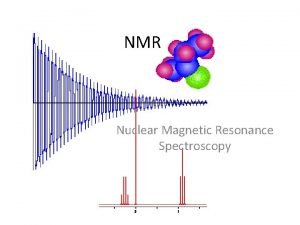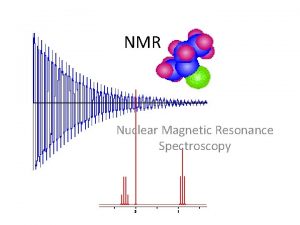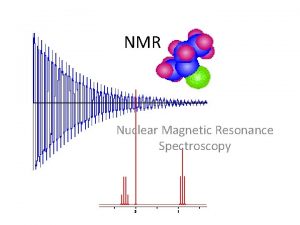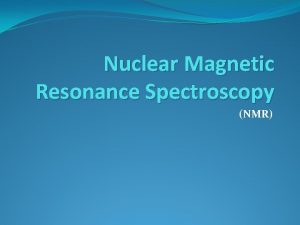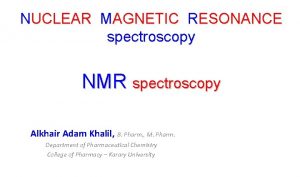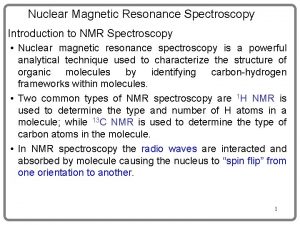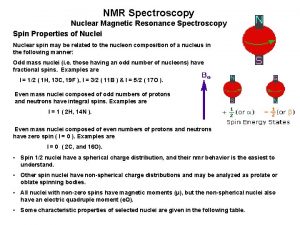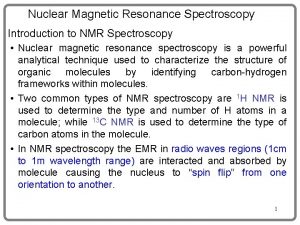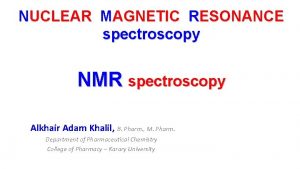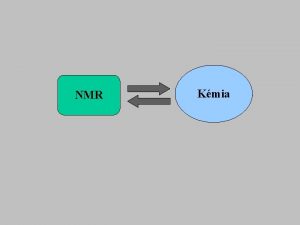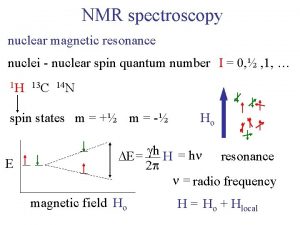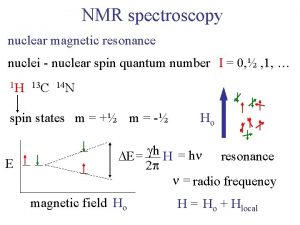NMR Spectroscopy Interpretation of NMR spectrum Nuclear Magnetic



















- Slides: 19

NMR Spectroscopy Interpretation of NMR spectrum

Nuclear Magnetic Resonance Spectroscopy 1 H NMR—The Spectrum • An NMR spectrum is a plot of the intensity of a peak against its chemical shift, measured in parts per million (ppm).

Nuclear Magnetic Resonance Spectroscopy 1 H NMR—The Spectrum Ø NMR absorptions generally appear as sharp peaks. Ø Increasing chemical shift is plotted from left to right. Ø Most protons absorb between 0 -10 ppm. Ø The terms “upfield” and “downfield” describe the relative location of peaks. Upfield means to the right. Downfield means to the left. Ø NMR absorptions are measured relative to the position of a reference peak at 0 ppm on the d scale due to tetramethylsilane (TMS). Ø TMS is a volatile inert compound that gives a single peak upfield from typical NMR absorptions.

Nuclear Magnetic Resonance Spectroscopy Features of 1 H NMR spectrum • Four different features of a 1 H NMR spectrum provide information about a compound’s structure: – Position of signals – Number of signals – Intensity of signals. – Spin-spin splitting of signals.

Magnetic Shielding If all protons absorbed the same amount of energy in a given magnetic field, not much information could be obtained. But protons are surrounded by electrons that shield them from the external field. Circulating electrons create an induced magnetic field that opposes the external magnetic field.

Shielded Protons Magnetic field strength must be increased for a shielded proton to flip at the same frequency.

Protons in a Molecule q Depending on their chemical environment, protons in a molecule are shielded by different amounts.

(a) (b) Electron drawing (a) CH 3 -CH 2 -Br Electron rich shielded (low frequency) Electron poor deshielded (high frequency) (b) Electron drawing (c) CH 3 -CH 2 -O-CH 2 -Br Electron rich shielded (low frequency) Electron poor more deshielded (high frequency) Shielding: Deshielding: nucleus feels weak magnetic field nucleus feels strong magnetic field Reduced energy gap ∆E Increased energy gap ∆E Lower frequency needed to achieve resonance Higher frequency needed to achieve resonance Electron dense (rich) means upfield chemical shift Electron dense (poor) means downfield chemical shift Ø The shifts in the positions of NMR signals resulting from the Shielding/Deshielding by the Electrons is called as "CHEMICAL SHIFTS"

Factors affecting chemical shift Chlorine "deshields" the proton, that is, it takes valence electron density away from carbon, which in turn takes more density from hydrogen deshielding the proton. Factors affecting chemical shift Electronegativity inductive effect Anisotrophic effect Hydrogen bonding Vanderwaal’s deshielding Electronegative element Dependence of the chemical shift of CH 3 X on the element X Compound CH 3 X CH 3 F CH 3 OH CH 3 Cl CH 3 Br CH 3 I CH 4 (CH 3)4 Si Element X F O Cl Br I H Si EN 4. 0 3. 5 3. 1 2. 8 2. 5 2. 1 1. 8 Chemical shift 4. 3 3. 40 3. 1 2. 7 2. 2 1. 0 0 Most deshielded Deshielding increases with EN of atom X q The chemical shift of a C—H bond increases with increasing alkyl substitution. RCH 2 -H R 2 CH-H R 3 C-H 0. 9 ppm 1. 3 ppm 1. 7 ppm Increasing alkyl substitution, increasing chemical shift TMS

Factors affecting chemical shift Substitution effects on chemical shift q The effect increases with greater numbers of electronegative atoms Factors affecting chemical shift Electronegativity inductive effect Anisotrophic effect Hydrogen bonding CH 4 CH 3 Cl CH 2 Cl 2 CHCl 3 1. 0 3. 1 5. 3 7. 3 q The effect decreases with increasing distance from the electronegative atom. The effect completely vanished at the fourth bond from the electronegative atom -CH 2 -Br X-CH 2 -CH 2 -Br 3. 3 1. 7 1. 3 1. 6 ppm 0. 9 ppm 3. 3 ppm q The effect of absence of electronegative atoms Methylene Methine Vanderwaal’s deshielding 0. 9 ppm 1. 2 ppm 1. 7 ppm

Factors affecting chemical shift Electronegativity inductive effect Anisotrophic effect Hydrogen bonding Vanderwaal’s deshielding Characteristic Values of Chemical Shifts q It is possible to predict the chemical shifts for the protons in a wide variety of compounds, including alcohols, ethers, ketones, esters, and carboxylic acids.

Factors affecting chemical shift Electronegativity inductive effect Anisotrophic effect Hydrogen bonding Vanderwaal’s deshielding Effects on neighbouring functional groups on chemical shift

Factors affecting chemical shift Electronegativity inductive effect Anisotrophic effect Hydrogen bonding Vanderwaal’s deshielding q The opposite of isotropy which means uniformity in all directions. q So, anisotropy is non -uniformity. q Now for different compounds this anisotropy is different as different distribution of electrons around nuclei. These compounds are: § Alkene § Alkyne § Benzene § Others

Factors affecting chemical shift § Alkene § Electronegativity inductive effect Anisotrophic effect Hydrogen bonding Vanderwaal’s deshielding protons adjacent to alkene (C=C-H) are deshielded by anisotropy effect, so, chemical shift will be induced.

Factors affecting chemical shift Electronegativity inductive effect Anisotrophic effect Hydrogen bonding Vanderwaal’s deshielding § Alkyne §

Factors affecting chemical shift Electronegativity inductive effect Anisotrophic effect Hydrogen bonding Vanderwaal’s deshielding § Benzene In a magnetic field, the six π electrons in benzene circulate around the ring creating a ring current. § The magnetic field induced by these moving electrons reinforces the applied magnetic field in the vicinity of the protons. § The protons thus feel a stronger magnetic field and a higher frequency is needed for resonance. Thus they are deshielded and absorb downfield. §

Factors affecting chemical shift § Others Factors affecting chemical shift Electronegativity inductive effect Anisotrophic effect Hydrogen bonding Vanderwaal’s deshielding

Factors affecting chemical shift § Hydrogen bonding (HB) effect § Electronegativity inductive effect The chemical shift depends on how much HB is taking place (observed in high conc. solutions. § HB lengthens the O-H bonds and reduces the valence electron density around the proton, so, it is deshielded and shifted Anisotrophic effect downfield in the NMR spectrum. § Alcohols vary in chemical shift from 0. 5 ppm (free OH) to about Hydrogen bonding Vanderwaal’s deshielding 5. 0 ppm (lots of HB).

Factors affecting chemical shift § Vanderwaal's Dishielding § Electronegativity inductive effect In overcrowded molecules, it is possible that some protons may be occupying sterically hindered position. § Electronegative cloud of bulky groups (hindering groups) will tend to repell the electron cloud surrounding proton. Anisotrophic effect § Thus, such a proton will be deshielded and will resonate a slightly higher values of δ (chemical shift) than expected in the Hydrogen bonding Vanderwaal’s deshielding absence of this effect
 Nmr spectroscopy
Nmr spectroscopy Factors influencing chemical shift
Factors influencing chemical shift Dept nmr spectroscopy
Dept nmr spectroscopy Advantages and disadvantages of spectroscopy
Advantages and disadvantages of spectroscopy Cyclohexane nmr splitting
Cyclohexane nmr splitting Ch3ch2occh2ch3
Ch3ch2occh2ch3 Evans nmr
Evans nmr Lesson 15 nuclear quest nuclear reactions
Lesson 15 nuclear quest nuclear reactions Fisión nuclear vs fision nuclear
Fisión nuclear vs fision nuclear Nuclear magnetic resonance applications
Nuclear magnetic resonance applications D orbital shape
D orbital shape Absorption spectrum vs emission spectrum
Absorption spectrum vs emission spectrum Em spectrum wavelength
Em spectrum wavelength Pie graph of electromagnetic waves
Pie graph of electromagnetic waves How does interpretation b differ from interpretation a
How does interpretation b differ from interpretation a Magnetic moment and magnetic field relation
Magnetic moment and magnetic field relation Force on charged particle
Force on charged particle Types of ferrites
Types of ferrites Magnetic field unit in weber
Magnetic field unit in weber Slit spectroscopy
Slit spectroscopy
